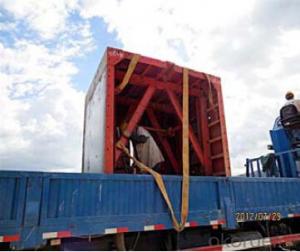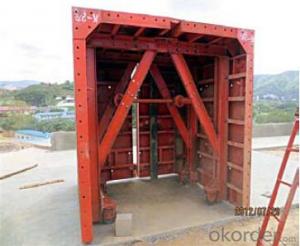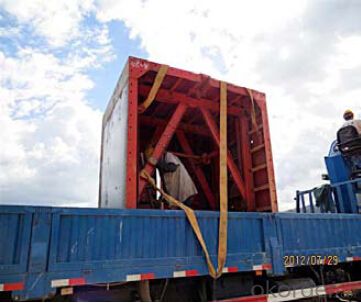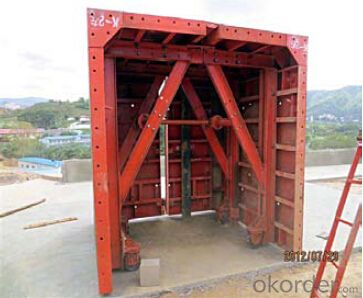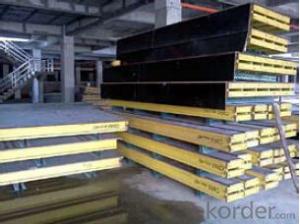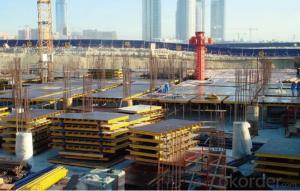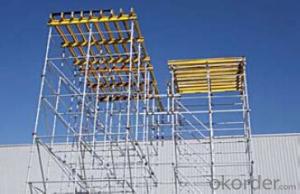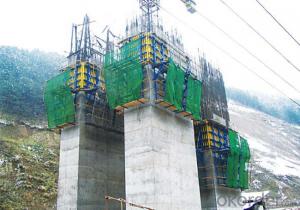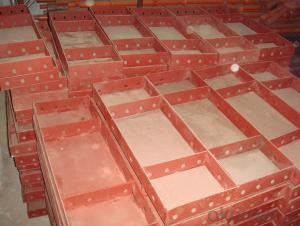Steel tunnel for formwork and scaffolding system
- Loading Port:
- Tianjin
- Payment Terms:
- TT OR LC
- Min Order Qty:
- 50 m²
- Supply Capability:
- 1000 m²/month
OKorder Service Pledge
Quality Product, Order Online Tracking, Timely Delivery
OKorder Financial Service
Credit Rating, Credit Services, Credit Purchasing
You Might Also Like
Building Tunnel Formwork:
A compositional steel formwork system mainly used in the building which has regular structure
without beams, the excellent formwork system can make the integral pouring for the wall & slab
easily achieved.
Characteristics:
◆ High stiffness, make perfect shape for concrete.
◆ Easy operation, save labor and force.
◆ Fast forming, repeatedly turnover.
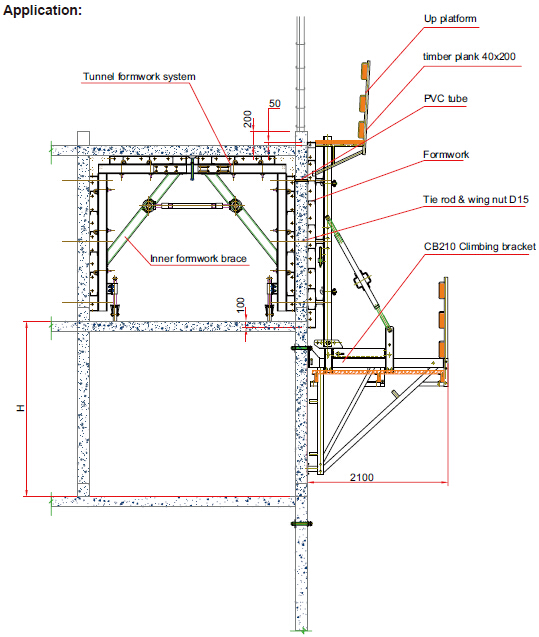
- Q: How does steel formwork prevent concrete segregation during pouring?
- Steel formwork prevents concrete segregation during pouring by providing a rigid and stable structure to hold the concrete in place. The steel panels are designed to be strong and durable, ensuring that they do not deform or flex under the weight and pressure of the concrete. This prevents the concrete from separating and segregating, which can occur if the formwork is not sturdy enough. Additionally, steel formwork is designed with tight joints and connections, minimizing the risk of leakage. This is important because if water from the concrete mixture leaks out, it can lead to the separation and settling of the aggregates, resulting in segregation. The tight joints also help in maintaining the desired shape and dimensions of the concrete structure. Furthermore, steel formwork is often coated or treated to prevent any chemical reaction between the concrete and the steel. This is important as such reactions can cause the concrete to segregate and weaken over time. By providing a strong and stable framework, preventing leakage, and avoiding chemical reactions, steel formwork ensures that the concrete mixture remains homogeneous and properly integrated, thus preventing segregation during pouring.
- Q: Can steel formwork be used in bridge construction projects?
- Yes, steel formwork can be used in bridge construction projects. Steel formwork offers several advantages such as durability, flexibility, and reusability, making it a suitable choice for constructing bridges. It provides the necessary support and structure during the concrete pouring process, ensuring the bridge's strength and stability. Additionally, steel formwork allows for faster construction and can be customized to meet specific design requirements, making it a preferred option for many bridge construction projects.
- Q: Can steel formwork be easily transported to different job sites?
- Indeed, steel formwork can effortlessly be transported to various worksites. Renowned for its sturdiness and robustness, steel formwork is ideal for repeated utilization and convenient transportation. It can be dismantled and reassembled without compromising its structural soundness, enabling effortless transportation to diverse destinations. Furthermore, unlike alternative formwork types, steel formwork is lightweight, rendering it more manageable to handle and transport using conventional construction machinery or vehicles. The adaptability and portability of steel formwork render it an esteemed preference for construction ventures necessitating frequent relocation between worksites.
- Q: How does steel formwork handle different concrete expansion properties?
- Steel formwork is a highly durable and rigid material that can easily handle different concrete expansion properties. Its strength and stiffness allow it to withstand the pressure exerted by expanding concrete without deforming or cracking. Additionally, steel formwork is typically designed with expansion joints or gaps, which provide sufficient space for the concrete to expand and contract without causing any structural issues. This ensures that the formwork remains intact and maintains its shape, allowing for successful concrete pouring and curing.
- Q: Can steel formwork be used for pre-stressed concrete elements?
- Pre-stressed concrete elements can indeed utilize steel formwork. Steel formwork is an adaptable and long-lasting alternative for the construction of such elements. It provides the necessary support and containment for the concrete throughout the pre-stressing process, ensuring the maintenance of its shape and strength. The suitability of steel formwork for pre-stressed concrete elements is due to its ability to bear substantial loads and withstand the forces and pressures involved in the pre-stressing process. Additionally, it enables precise control over the form and dimensions of the concrete element, guaranteeing accurate and consistent outcomes. Moreover, steel formwork is reusable, making it a cost-effective option for pre-stressed concrete construction projects. It can be easily assembled, disassembled, and adjusted to accommodate various shapes and sizes of pre-stressed elements. In conclusion, steel formwork is a suitable and commonly employed choice for the construction of pre-stressed concrete elements because of its strength, versatility, and cost-effectiveness.
- Q: Can steel formwork be used in healthcare or medical facility construction projects?
- Indeed, healthcare or medical facility construction projects can utilize steel formwork. Steel formwork is a flexible and long-lasting solution that is often favored in construction endeavors due to its robustness, stability, and ability to be reused. When it comes to healthcare or medical facility construction, steel formwork offers numerous benefits. First and foremost, steel formwork provides exceptional structural integrity, which is crucial in healthcare facilities where safety and stability are of utmost importance. It can endure heavy loads and serve as a solid foundation for concrete walls, columns, and slabs. This is particularly vital in areas like operating rooms or intensive care units where precision and stability are crucial. Secondly, steel formwork is highly adaptable and can be easily tailored to meet specific design requirements. Healthcare facilities often have unique layouts and intricate architectural features, and steel formwork can be fabricated to accommodate these complexities. Whether it involves shaping curved walls, circular columns, or irregular forms, steel formwork offers the necessary flexibility to bring the design vision to life. Furthermore, steel formwork is renowned for its reusability. In healthcare projects where time and cost efficiency are paramount, reusing formwork can significantly reduce construction time and expenses. Steel formwork can be swiftly disassembled, cleaned, and reassembled for future projects, making it an environmentally friendly and cost-effective choice. Lastly, steel formwork exhibits exceptional resistance to fire, moisture, and adverse weather conditions. In healthcare facilities, where cleanliness and infection control are critical, the non-porous surface of steel formwork can be easily cleaned and maintained. Additionally, it provides excellent fire protection, ensuring the safety of patients and staff. In conclusion, steel formwork is undeniably suitable for healthcare or medical facility construction projects. Its strength, adaptability, reusability, and durability make it an ideal choice for creating secure and functional spaces in healthcare facilities.
- Q: Can steel formwork be used for curved or irregular-shaped structures?
- Yes, steel formwork can be used for curved or irregular-shaped structures. Steel formwork is highly versatile and can be easily fabricated to suit different shapes and sizes. Its strength and flexibility allow it to be molded and adjusted to create curved or irregular forms, providing the necessary support and shape for these types of structures during the construction process.
- Q: How does steel formwork handle extreme weather conditions?
- Steel formwork is highly durable and can withstand extreme weather conditions with ease. Its strength and resilience make it suitable for use in various climates, ranging from hot and humid to cold and snowy. In hot weather conditions, steel formwork remains stable and does not warp or deform due to high temperatures. Its high melting point ensures that it retains its shape and structural integrity even under intense heat. Additionally, steel formwork does not absorb moisture or expand, preventing any potential damage caused by expansion and contraction in hot and dry environments. In cold weather conditions, steel formwork remains unaffected by freezing temperatures and does not become brittle. It can withstand the weight of snow loads without any risk of collapse. Steel formwork also prevents the absorption of moisture, eliminating the risk of freeze-thaw damage. Furthermore, steel formwork is resistant to corrosion, making it suitable for use in areas with high humidity or exposure to saltwater. Its corrosion resistance properties ensure that the formwork remains strong and functional, even when exposed to extreme weather conditions over an extended period. Overall, steel formwork's ability to handle extreme weather conditions is a result of its exceptional strength, durability, and resistance to temperature variations, moisture, and corrosion. These qualities make it a reliable and long-lasting choice for construction projects in various climates across the globe.
- Q: Are there any specific safety guidelines for steel formwork construction?
- Yes, there are specific safety guidelines that should be followed during steel formwork construction. Some of the key safety guidelines include: 1. Personal Protective Equipment (PPE): All workers involved in steel formwork construction should wear appropriate PPE, such as hard hats, safety goggles, gloves, and steel-toed boots. This helps protect against potential hazards like falling objects, flying debris, and impact injuries. 2. Fall Protection: Adequate fall protection measures should be in place to prevent falls from heights. This may include the use of guardrails, safety nets, or personal fall arrest systems (PFAS) depending on the height and nature of the work being carried out. 3. Structural Stability: Before starting the construction process, it is important to ensure that the steel formwork structure is stable and properly braced to prevent collapse or structural failure. Regular inspections should be conducted to identify any signs of weakness or damage and immediate corrective actions should be taken. 4. Proper Handling and Storage: Steel formwork components should be handled with care and stored in a secure manner to prevent accidents and injuries. Safe lifting techniques should be followed to avoid strains and muscle injuries. 5. Electrical Safety: If electrical equipment is being used during the construction process, it is important to follow electrical safety guidelines. This may include grounding the equipment, using proper insulation, and ensuring that electrical connections are secure. 6. Hazard Communication: All workers should be aware of the potential hazards associated with steel formwork construction, and proper communication and training programs should be in place to educate them about these hazards and the necessary safety precautions. 7. Regular Maintenance: Regular inspections and maintenance of the steel formwork system should be conducted to ensure its integrity and safe use. Any identified defects or damages should be repaired or replaced promptly. It is important to note that these guidelines may vary depending on the specific project, local regulations, and industry best practices. It is recommended to consult with industry experts and adhere to any additional safety guidelines that may apply to the specific steel formwork construction project.
- Q: I would like to ask you 60 models of building steel formwork, steel mold fixed method and fixed plate type fixed hole number
- P6015:600 * 1500mm, P6012:600 * 1200mm, P6009:600 * 900mm, construction templates generally use U card or bolt fixation
Send your message to us
Steel tunnel for formwork and scaffolding system
- Loading Port:
- Tianjin
- Payment Terms:
- TT OR LC
- Min Order Qty:
- 50 m²
- Supply Capability:
- 1000 m²/month
OKorder Service Pledge
Quality Product, Order Online Tracking, Timely Delivery
OKorder Financial Service
Credit Rating, Credit Services, Credit Purchasing
Similar products
Hot products
Hot Searches
Related keywords
